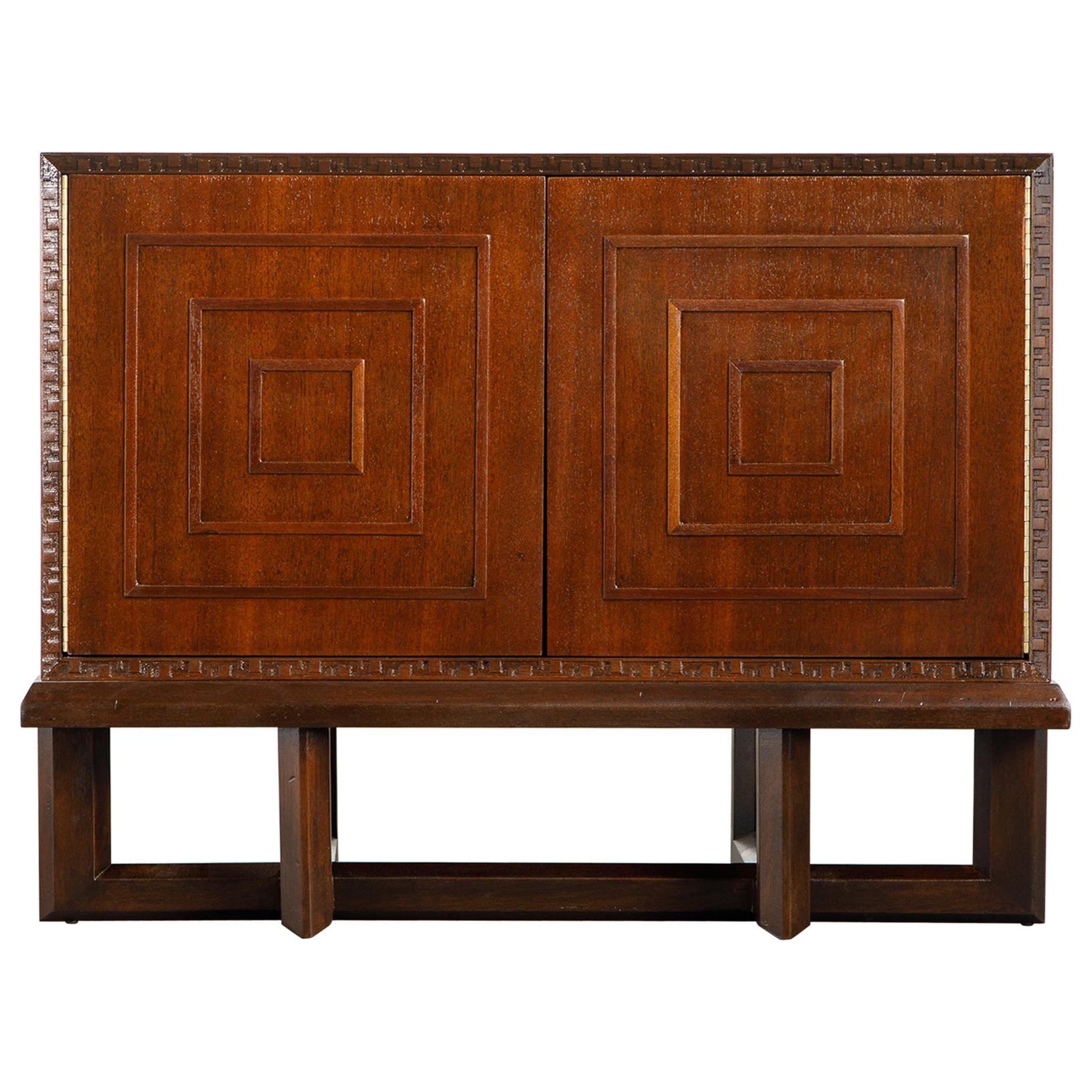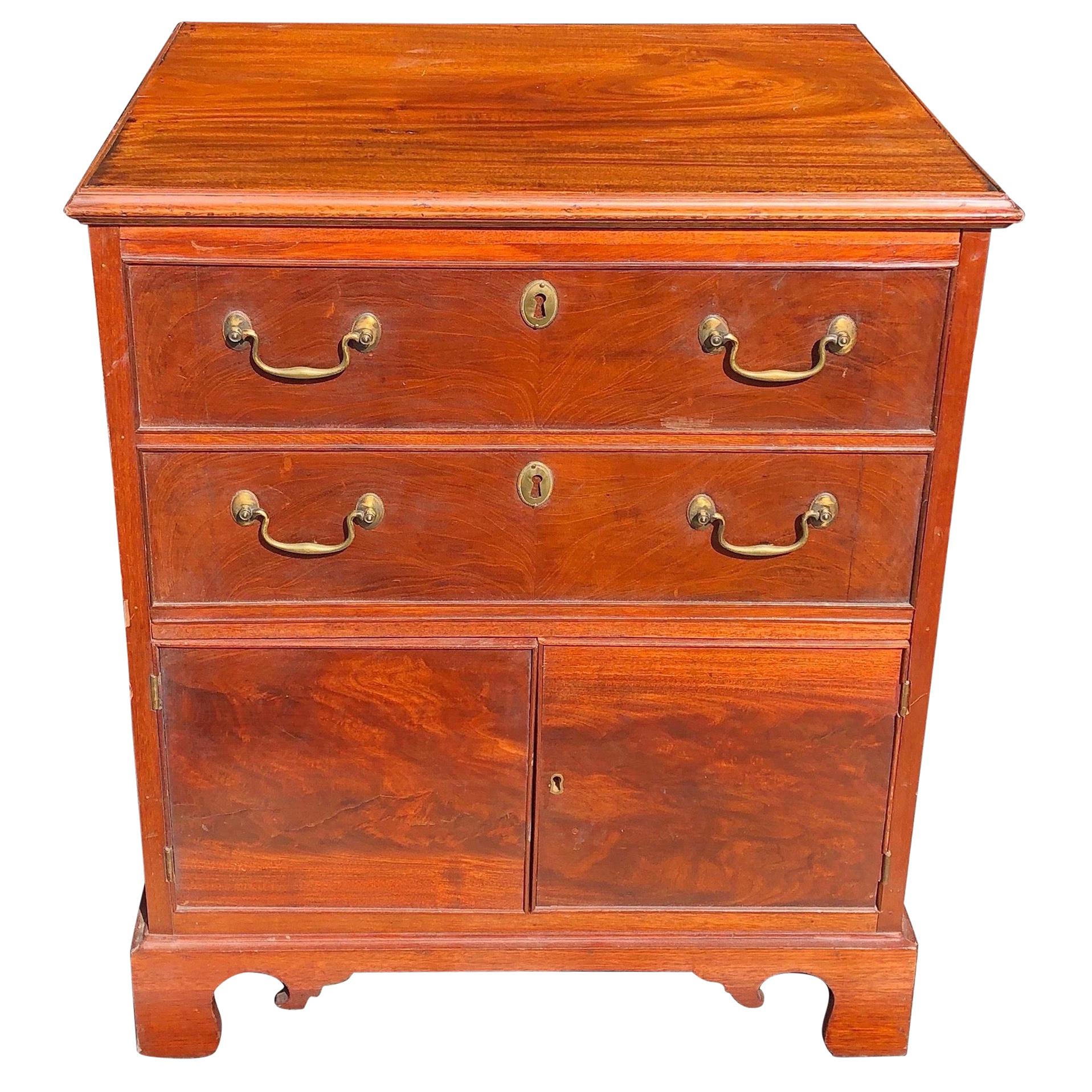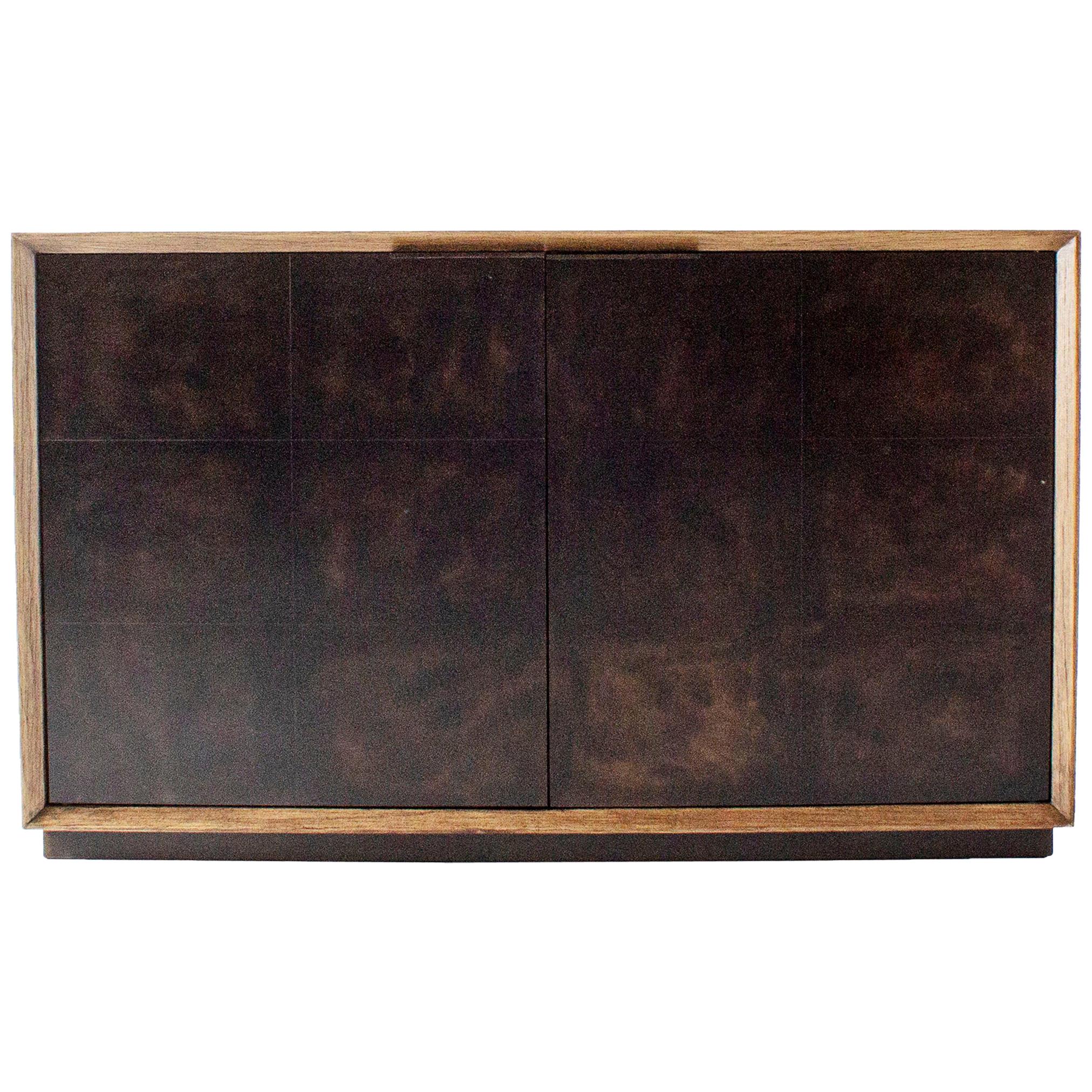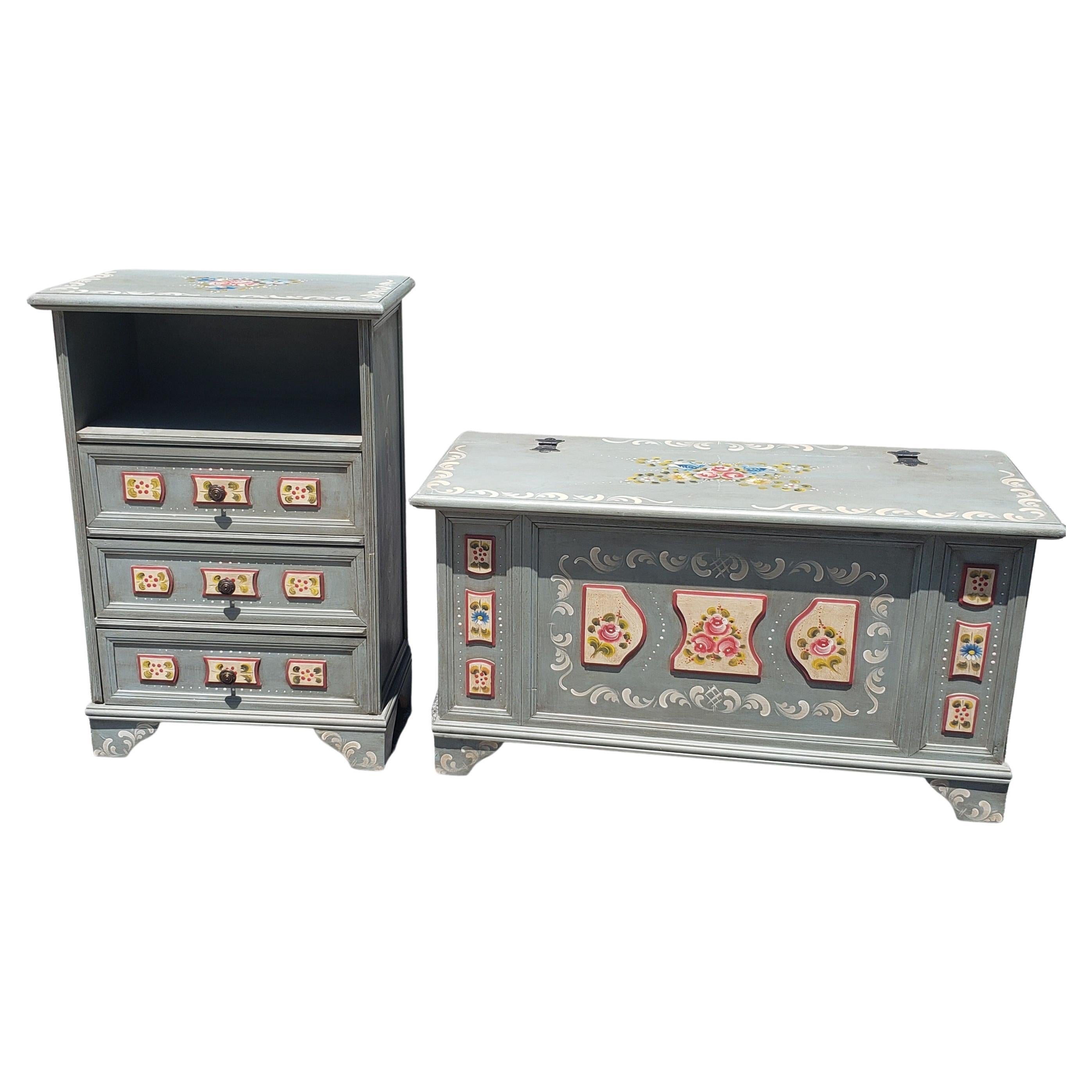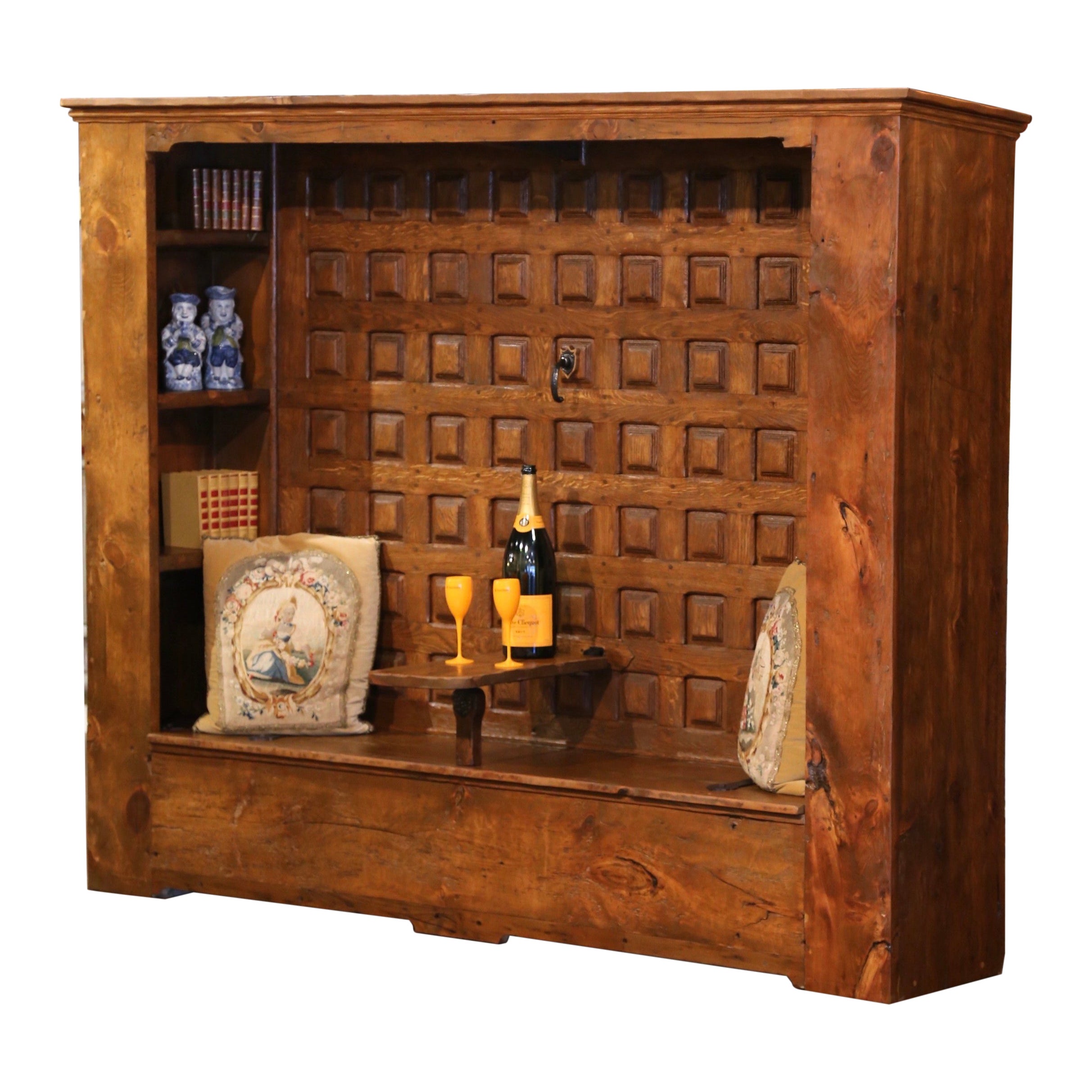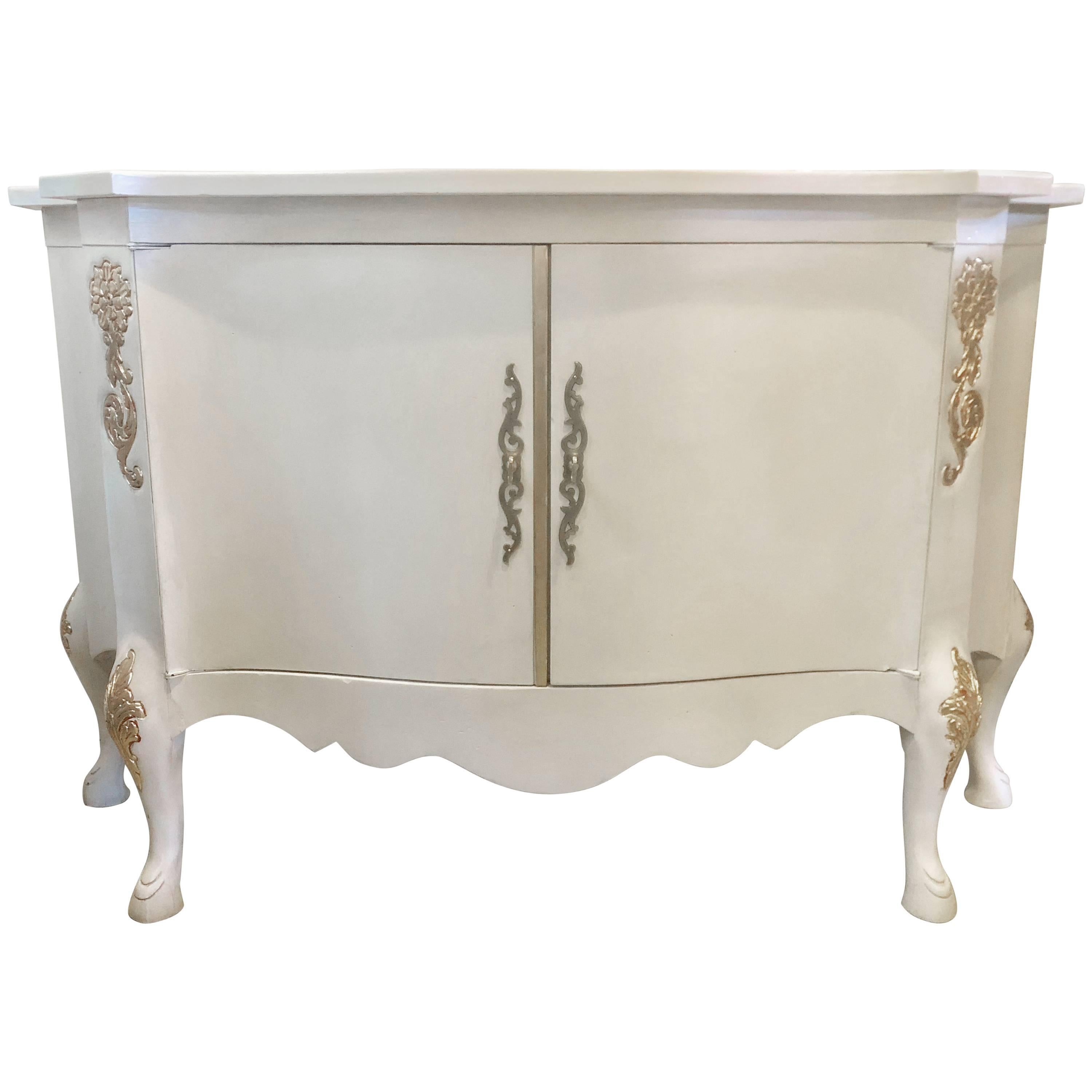Items Similar to Amazing Serigraphed Cabinet by Artist Emilio Tadini, Published Casa Vogue
Want more images or videos?
Request additional images or videos from the seller
1 of 11
Amazing Serigraphed Cabinet by Artist Emilio Tadini, Published Casa Vogue
About the Item
Beautiful and super rare 'Cassapanca di buona memoria' (chest of beautiful memories) by famed Italian artist Emilio Tadini (1927-2002). Tadini was invited to exhibit his paintings at the Venice Biennale in both 1978 and 1982 and was a true polymath in that he was also equally impressive as an artist, sculptor and poet. Umberto Eco, in a eulogy, said of him "a painter who writes, a writer who paints."
This design was a main feature in the September 1987 issue of Casa Vogue with photographs taken by the famed photographer Aldo Ballo. Please see image 2. The five visible external surfaces, including the hinged top, are covered in beautiful and vibrant original serigraphs by Tadini.
This design was produced in both black and white with the Casa Vogue reviewer stating that the black version was the most precious of the two. The black version of this design was also exhibited in 2014 at the Spazio Tadini, museum and exhibition space, in Milan. Please see image 10.
These exclusive cabinets were produced in very small numbers, circa 1930-1950 examples is estimated, by the Italian company Interflex in the 1980s.Unfortunately Interflex no longer exists and closed its doors in the early 1990s.
This example still retains its original castors and is in very nice original condition.
A beautiful and rare piece fit to grace any home.
Literature: Casa Vogue, issue September 1987, page 281. Please see image 2.
BIOGRAPHY
A writer who paints, a painter who writes.” - Umberto Eco
Emilio Tadini (b. 1927 – d. 2002 Milan, Italy) is considered one of the most original personalities of Italy’s post - World War II cultural landscape. A Poet, novelist, essayist, art critic, journalist and painter, he was, in the words of friend and contemporary Umberto Eco, “A writer who paints, a painter who writes.”
In 1947 he debuted with a poem in Elio Vittorini's magazine Politecnico, which was followed by intense critical and theoretical writings on art. From 1963 to 1993 Tadini published four novels and a volume of poems. It was alongside his critical and literary work, from the late 1950s Tadini began to paint. His first solo exhibition was in 1961 at the Galleria del Cavallino in Venice, and then in 1965, in a group show, together with Mario Schifano, Valerio Adami and Lucio Del Pezzo at the newly opened Studio Marconi in Milan.
Although stylistically ‘Pop’ Tadini, rather than the superficial gloss of American Pop Art, was greater interested in the more introspective, personal, and at times intellectual British Pop Art such as Ronald Kitaj, Peter Blake, David Hockney and Allen Jones, but also to that of Francis Bacon, Patrick Caufield, and the figurative narratives of Valerio Adami and Hervé Télémaque.
Tadini developed a distinctive graphic painting style producing thematic cycles of works like serialised novels- each telling a story; Color & Co. (1969), Journey in Italy (1971) and Archaeology (1972), examples of which are exhibited here. We tentatively follow the protagonist in Life of Voltaire (1967) the first large scale cycle into a fantastic, dreamlike world, the everyday characters and objects are juxtaposed with the surreal, the comic with the tragedy and the fantastic with the mundane. With influences of Cubism and Surrealism, seemingly simple, straightforward images hide a multiplicity of meanings, deal with metaphysical principles and philosophy, pictorial streams of consciousness that develop over the entire series: from one image emerges others that modify and alter it. With a masterly ability Tadini controls two kinds of languages, the visual and the literary, his work is a place of convergence for the two forms of expression.
During the 1970s he had solo exhibitions in Paris, Stockholm, Brussels, London, Antwerp, the United States and Latin America, both in private galleries and in public spaces and museums. In 1978 and 1982 Tadini participated in the Venice Biennial, and in 1986 he had a large solo exhibition at the Rotonda di via Besana in Milan. From autumn 1995 to the summer of 1996 a major retrospective travelling exhibition took place in the museums of Stralsund, Bochum and Darmstad. In spring 2005, the Villa dei Cedri Museum in Bellinzona had a large posthumous retrospective of his work.
His extraordinary range of disciplines also included sculpture, textile and furniture design, as well as advertising; collaborating with various companies such as Renault and Gazzetta dello Sport creating for example the image of the 84 Giro d'Italia. Emilio Tadini is in the permanent collections of Civic Gallery of Modena, National Gallery of Modern and Contemporary Art, Rome, Museum of the twentieth century, Milan, and Mambo - Museum of Modern Art, Bologna.
- Creator:Emilio Tadini (Artist)
- Dimensions:Height: 19.89 in (50.5 cm)Width: 55.12 in (140 cm)Depth: 20.28 in (51.5 cm)
- Materials and Techniques:
- Place of Origin:
- Period:1980-1989
- Date of Manufacture:1987
- Condition:Wear consistent with age and use. Lovely original condition, serigraphs in very good order. A very well looked after piece.
- Seller Location:bergen op zoom, NL
- Reference Number:1stDibs: LU93013261902
About the Seller
4.9
Platinum Seller
These expertly vetted sellers are 1stDibs' most experienced sellers and are rated highest by our customers.
Established in 1999
1stDibs seller since 2012
366 sales on 1stDibs
Typical response time: 1 hour
- ShippingRetrieving quote...Ships From: bergen op zoom, Netherlands
- Return PolicyA return for this item may be initiated within 7 days of delivery.
More From This SellerView All
- Morgana mirrors by Cortesi & Chiappa-Catto 1970, published CASA VOGUE, SignedBy Angelo Cortesi and Sergio Chiappa-GattoLocated in bergen op zoom, NLSuperb and super rare pair of MORGANA mirrors designed by Angelo Cortesi and Sergio Chiappà -Catto. The frames of these mirrors are finished in aluminum brushed orthogonally to create a wonderful three dimensional op art interplay of light and shadow from a simple flat surface. This design clearly imbues the influence of important italian artist Getulio Alviani's masterful series of 'superficie a testura vibratile' (surfaces of vibrating textures). The central square opening was designed to either accomodate a mirror or a jewel like object of choice or a photo , a cameo etc. This is documented in the Formaluce February 1971 article. The Morgana mirrors were artisan produced in 1970 for the exclusive 'Forme e superficie' (forms and surfaces) gallery in Turin ,Italy. Both mirrors retain their original manufacturer's labels. 'Forme e superficie" employed some of the most brilliant local artists, designers and sculptors such as Nerone and Patuzzi to produce art and design pieces in exclusive small editions. Cortesi and Chiappà -Cattò are well known for their beautiful 'Cicindela'and 'Angolo' light sculptures also produced by Forme e Superficie. The Morgana mirrors were published in:- CASA...Category
Vintage 1970s Italian Minimalist Wall Mirrors
MaterialsAluminum
- Unique Rosewood Cabinet by Vittorio Dassi with Painting by Pietro Toppi, 1955By Vittorio Dassi, Consorzio Esposizione Mobili CantùLocated in bergen op zoom, NLStunning unique rosewood storage cabinet designed by Vittorio Dassi, Italy with unique hand painted panel signed by the famous Italian artist Pietro Toppi. This cabinet was clearly a...Category
Vintage 1950s Italian Mid-Century Modern Sideboards
MaterialsBrass
- Rare PANAMARENKO Artist Catalogue Raisonne by Hans Theys Belgium published 1994Located in bergen op zoom, NLRare Catalogue Raisonne of Belgian Artist PANAMARENKO about impudent collages, trembling artists and a snap of the fingers. About smokescreens, specificity and form. In which the re...Category
Late 20th Century Belgian Post-Modern Books
MaterialsPaper
- Case Study Prototype "Weaving" by Atelier Tejo Remy & Rene VeenhuizenBy Tejo RemyLocated in bergen op zoom, NLDutch designers Atelier Tejo Remy & Rene Veenhuizen is always experimenting with new techniques and (recycling) materials to create living spaces and furnitu...Category
2010s Dutch Modern Cabinets
MaterialsSteel
- Rare Free-Form Table by Sculptor Knut Hesterberg, PublishedBy Knut HesterbergLocated in bergen op zoom, NLThis beautiful and elegant free-form table by German sculptor Knut Hesterberg was produced by the German company, Ronald Schmidt, in very small numbers during the short period of 1974-1975 and so is very rarely seen on the market. The sculptural base is made of pressure die cast aluminium. This design is published as Figure 30 in Belloli's monograph on Hesterberg's work entitled "Knut Hesterberg, Skulptur and design" by Carlo Belloli, Milan, Italy which was published in 1983. A copy of the original page documenting this table will be provided to the buyer. (please see image 4). Knut Hesterberg is a world famous German sculptor who started his career at the graphic arts and design studio in Zurich, Switzerland where he came into contact with the architect and artist Max Bill who had a great influence on his future work. He has exhibited his sculptures all over Europe and many of his large scale sculptures are permanently installed in public spaces throughout Germany and a few in Italy (please see image 10 for an example) . In the late 1960s he was asked to design a series of limited production sculptural form tables...Category
Vintage 1970s German Coffee and Cocktail Tables
MaterialsGlass
- Henk Stallinga 'One Nightstand' Chair Droog Design, The Netherlands, 1996By Henk StallingaLocated in bergen op zoom, NLThis unique pair of 'one nightstand' chairs comes from a private collection and only three were ever produced It was commissioned by the Aids Foundation in 1995 Henk Stallinga...Category
1990s Dutch Minimalist Chairs
MaterialsBirch, Plywood
You May Also Like
- 'Taliesin' Model #2005 Special Cabinet by Frank Lloyd Wright, 1955, SignedBy Heritage-Henredon, Frank Lloyd WrightLocated in Los Angeles, CAThis gorgeously refinished Honduran Mahogany 'Taliesin' Model #2005 Special Cabinet on Stand was designed by Frank Lloyd Wright for Heritage-Henredon in 1955 and produced only for two years, therefore is now a highly sought-after and rare collectors item and this particular cabinet design being one of the most sought after of the entire collection. This example is signed with the red Taliesin symbol on the back along with its stamped model #2005. This rare Frank Lloyd Wright cabinet features the rare sought after architectural base with equally rare and sought after two door cabinet with concentric square designs on doors. Inside the cabinet is a removable shelf. The cabinet can be removed from the base as can be seen in the photos. Frank Lloyd Wright stated that one of his goals for this line was for the 'design to make the home more efficient as well as more beautiful'. Woven into each piece of this series was the chamfered wood edge with an abstracted Greek key motif, the signature detail of every Taliesin design, covering the edges of each item in the collection. All of the pieces were executed in Honduran Mahogany, a high-end luxury wood choice. His idea was to design ‘infinite adaptability to American living’, for example desks could double as dressing tables, small tables could be used as a chair or stool and bookcases had moveable tops transforming into room dividers. Decoration was limited to the greek key edges so that ‘is of the piece, not on it’ and the removal of elimination of any hardware door or drawer pulls in favor of cut out flush pulls which ‘catch light and shadow for interesting and changing patterns’. Wright pitched three separate concepts to Heritage Henredon: ‘Burberry’, ‘Honeycomb’ and ‘Four Square’ which was the one chosen to go into production and renamed ‘Taliesin’ after Wrights Wisconsin home. A distinguishing feature of the Taliesin line is that each piece is identified with a branded signature which was often accompanied by a red square. No other items from the rest of Wright's career is marked or identified which makes this line more desirable to collectors. This particular cabinet design recently broke auction records for its model - demonstrating the rarity and desirability of Frank Lloyd Wright's work along with the uniqueness of this cabinet design and demand from art and design collectors and investors, along with the interior design community. This beautiful Frank Lloyd Wright Taleisin cabinet would work great in a Craftsman, Farm House, Monterey, Spanish, Mission, Arts & Crafts, Mid-Century Modern, Scandanavian Modern or Danish Modern home or penthouse apartment but could also look fantastic in a Contemporary or Post-Modern room. Also consider mixing it up in a Traditional, Transitional, Classical or Art Deco room with a splash of juxtaposition. Would also be an apt choice in a commercial project such as a hotel lobby lounge or members club, creative design studio or high-rise executive office. Consider using as a small blanket chest, a dry bar for liquor...Category
Vintage 1950s American Mid-Century Modern Cabinets
MaterialsMahogany
- 18th Century Mahogany CabinetLocated in Charleston, SC18th century mahogany cabinet that started its life as a bedchamber pot cabinet. Lift top for upper storage section, separated by lower section with do...Category
Antique Late 18th Century American Cabinets
MaterialsMahogany
- Modernist Inspired Two Door CabinetBy Brendan BassLocated in Dallas, TXFront: Beirut Finish Wood: Oak Metal: Zinc "Ebonized Bronze" Item can be customized. Finish, Zinc, Wood type and dimensions can all be customized. Designed by Brendan Bass for the ...Category
21st Century and Contemporary American Industrial Cabinets
MaterialsMetal, Zinc
- Modern Hand-Painted Pine Blanket Chest with Side Drawer CabinetLocated in Germantown, MDModern Hand-Painted Pine Blanket Chest with Side Drawers Cabinet in very good vintage condition. Hand painted on front and sides. Blanket chest measures 35 inches in width, 14.5" in...Category
Late 20th Century American Modern Blanket Chests
MaterialsWood, Pine, Paint
- French Pyrenees Carved Oak and Pine "Zuzulu" Bench Trunk Table Display CabinetLocated in Dallas, TXMake a focus point in a house with this interesting "all in one" antique blanket chest, bench, table and display cabinet! Crafted from solid 19th century oak from the French Pyrenees...Category
21st Century and Contemporary French Country Cabinets
MaterialsWrought Iron
- Louis XV Style Parcel-Gilt and Paint Decorated Two-Door Cabinet Server SideboardLocated in Stamford, CTLouis XV style parcel-gilt and paint decorated two-door cabinet server sideboard.Category
Mid-20th Century Louis XV Cabinets
MaterialsWood
Recently Viewed
View AllMore Ways To Browse
Amazing Rare
Cabinet Amazing
Amazing Space
Artist Storage
Vintage Artist Case
Artist Cabinet
Retro Travel Case
Cabinet On Castors
Large Scale Cabinet
Chest With Gallery
Four Door Long Cabinet
Small Scale Cabinet
Chest With Painting
Artist Painted Cabinets
Post Office Cabinet
Long White Cabinet
London Vintage Cabinet
Large Black Chest
